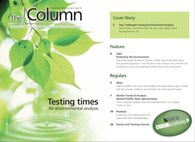Breast milk study
Agilent Technologies has announced that a group of researchers from the University of California, Davis, USA, has found that human breast milk contains an unexpected abundance of sugars that coats the lining of infants? intestines, protecting it from noxious bacteria.
Agilent Technologies has announced that a group of researchers from the University of California, Davis, USA, has found that human breast milk contains an unexpected abundance of sugars that coats the lining of infants’ intestines, protecting it from noxious bacteria. The research, which used the company’s technology, was published in the Proceedings of the National Academy of Sciences.1
“This type of research has been performed and duplicated many times in the past,” said Dr Carlito Lebrilla, co-author of the study. “However, the new technology made it possible to identify and quantify milk oligosaccharides providing new and important observations that could not be obtained in the past.”
HPLC chip and quadrupole time-of-flight LC–MS technology allowed researchers to identify more than 200 different oligosaccharide (sugar) structures in breast milk across stages of lactation among human mothers. Oligosaccharides are the third most abundant component in breast milk, but until now were thought to have no biological significance. This study suggests that the sugars may be used to enrich a specific “healthy” microbiota containing bifidobacteria — a major component of gut flora, which is thought to aid in digestion and discourage the growth of pathogens and harmful bacteria in infants.
A.M. Zivkovic, PNAS, on-line 2 August 2010.
This story originally appeared in The Column. Click here to view that issue.
Removing Double-Stranded RNA Impurities Using Chromatography
April 8th 2025Researchers from Agency for Science, Technology and Research in Singapore recently published a review article exploring how chromatography can be used to remove double-stranded RNA impurities during mRNA therapeutics production.









